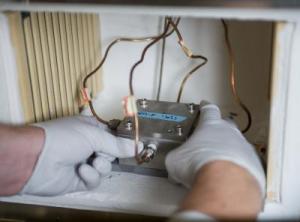Researchers have developed a microfluidic technique for fabricating a new class of metal-organic framework (MOF) membranes inside hollow polymer fibers that are just a few hundred microns in diameter. The new fabrication process, believed to be the first to grow MOF membranes inside hollow fibers, could potentially change the way large-scale energy-intensive chemical separations are done.
 This close-up photograph shows the prototype reactor module used to fabricate hollow-fiber metal-organic framework membranes at Georgia Tech using the interfacial microfluidic technique. Credit: Georgia Tech Photo: Rob Felt
This close-up photograph shows the prototype reactor module used to fabricate hollow-fiber metal-organic framework membranes at Georgia Tech using the interfacial microfluidic technique. Credit: Georgia Tech Photo: Rob Felt
The researchers believe the process can be scaled up to inexpensively provide large membrane surface areas in compact modules. By replacing energy-intensive distillation or cryogenic techniques, these molecular sieving membranes could cut the cost of gaseous and liquid separations, reduce energy consumption – and lead to industrial processes that generate less carbon dioxide. The researchers have demonstrated that membranes produced with the new technique can separate hydrogen from hydrocarbon mixtures, and propylene from propane.
Development of the membrane fabrication methodology was scheduled to be described in the July 4 issue of the journal Science.
"This work opens up new ways of fabricating molecular sieving separation membranes using microscopic hollow fibers as a platform," said Sankar Nair, a professor in the School of Chemical & Biomolecular Engineering at the Georgia Institute of Technology, and one of the paper's co-authors. "Many of the separations that currently are done with energy-intensive techniques could one day be performed with membranes fabricated by a scaled-up version of our methodology."
Energy-intensive separation processes are widely used in the industrial production of petro-based and bio-based fuels and chemicals, as well as a variety of other technological materials. The most common separation technique is distillation, which applies heat to chemical mixtures to drive off specific molecules according to their boiling points. Other techniques, such as crystallization, involve cooling to lower temperatures to separate the molecules from the mixtures.
In contrast, molecular sieving membranes use semipermeable materials to separate molecules from mixtures that are produced by chemical reactions or found in raw material feedstocks. The process may be driven by a pressure gradient, and relies on the membranes to preferentially pass certain molecules through their pore structures. Crystalline materials known as zeolites have been fabricated into membranes, but high membrane fabrication costs and a limited selection of materials have prevented their widespread use.
Metal-organic framework (MOF) materials offer an alternative with more benign fabrication methods and many thousands of material types available. But before MOF membranes could be used on a large scale, researchers had to find ways of producing them at low cost in large volumes.
The Georgia Tech technique for producing MOF membranes takes advantage of the large surface area that can be obtained by using large numbers of hollow fibers spun from inexpensive polymers. For instance, a one cubic meter hollow-fiber membrane module could contain as much as 10,000 square meters of membrane area.
The new fabrication process relies on a microfluidic technique for bringing the different reactants needed to form MOF membranes into contact inside the fibers. The inner diameter of the fibers may be 100 microns or less, limiting the amount of reactants present and changing the interplay of the physical and chemical forces that control membrane formation. By adjusting the flow and positioning of the reactants and their solvents, the researchers learned to control the location of the MOF membrane films, allowing their formation on the inside or outside of the fibers – and even within the structure of the fibers.
"We have combined a high-performance MOF material with a new fabrication technique to come up with a membrane that can be scaled up in an inexpensive way," Nair explained. "A key realization behind this development is that if you want to scale up MOF membrane growth using hollow fiber modules, you have to first learn how to scale down their growth in the microscopic environments of individual hollow fibers."
Once the researchers learned to fabricate a functional membrane using a single hollow fiber, they could simultaneously fabricate membranes in parallel on multiple hollow fibers that were pre-assembled into a module. The research reported in the journal produced membrane films made of the MOF ZIF-8 inside three fibers simultaneously. Ultimately, Nair believes large bundles of the polymer fibers could be pre-assembled into modules and then coated simultaneously with molecular sieving MOF membranes.
An important next step for the research is to develop a better microscopic understanding of the process.
"To optimize this technique and scale it up to thousands or even millions of fibers at a time, we need to dig deeper to understand how the chemical reactions and molecular transport processes leading to membrane formation can be controlled under the microscopic conditions that exist within the fibers," Nair said.
Though the researchers have so far demonstrated the functionality of their membranes in gaseous separation processes of interest to the petrochemical industry, the membrane processing technique could have broader applications.
"The approach we have developed could open the door to a whole new class of molecular sieving, polycrystalline film membranes," said Christopher Jones, a professor in the School of Chemical & Biomolecular Engineering and another of the paper's co-authors. "Such membranes could revolutionize how oil and chemical companies carry out gas and liquid separations, for example, by replacing energy-intensive and expensive cryogenic distillation processes with more energy-friendly membrane separations."